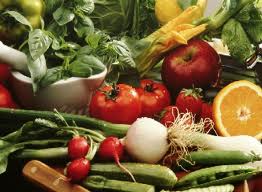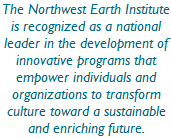You are currently browsing the tag archive for the ‘local food’ tag.
 We recently connected with Bonney Parker of Toms River, New Jersey per her past and present involvement with the Northwest Earth Institute discussion courses (she and her group are currently doing Discovering A Sense of Place).
We recently connected with Bonney Parker of Toms River, New Jersey per her past and present involvement with the Northwest Earth Institute discussion courses (she and her group are currently doing Discovering A Sense of Place).
Bonney told NWEI staffer Rob Nathan of how she and her sister have been presenting cooking workshops at a local organic farm three times a month (she has also written a cookbook based on this venture with her sister). Bonney says, “Some of our NWEI discussion group people are faithful attendees at the workshops, which have grown over the past two years from about 5 people to 30 people coming each time!” We asked Bonney if NWEI courses had influenced the process in any way (she and her group had done NWEI’s Hungry for Change: Food, Ethics and Sustainability course earlier this year). Here is what she said:
“Some of the attendees of the workshops became members of our discussion group, so NWEI has had an influence. Our thoughts and actions regarding the workshops and the subsequent cookbook have been influenced by what we have read. For instance, we now ask folks who come to the workshops to bring their own eating utensils and cloth napkins with them. I always have a supply of forks and spoons for those who forget, but that number is very small. We usually ask the owner/farmer who is present at the workshops to talk about how he farms and what certain plants are and how they grow and are useful, etc, in addition to our nutritional information about the dishes we make.”
Thanks Bonney for your continued involvement with NWEI, and for sharing this inspiring story with us – and for sharing an example of connecting to place and fostering sustainable food choices. Bonney notes that for the workshops her sister Maureen (pictured above at right) picks the seasonal produce with the farmer for that night’s workshop.
If you’d like to order the cookbook, or learn more about Bonney’s grassroots efforts, you can contact her at bonnpark7@aol.com.
Its that time again! October 1-15th brings NWEI’s 5th Annual EcoChallenge: an opportunity to change your life for good. For two weeks every October, we challenge you to change one habit for Earth. You choose your challenge, we connect you with other EcoChallengers, and collectively we prove that small actions create real change.
Check out this EcoChallenger Profile Video for ideas and to learn about NWEI volunteer Elise Lind’s Challenge from last year: to eat only food produced in Oregon and Washington. Then, choose your own challenge and sign up to participate now.
We look forward to your stories of change to come!
 Today we are checking back in with Sustainable Together, a blog by Shelly Randall (our guest blogger at NWEI’s bi-annual conference last year). We also wanted to see what was going on in Port Townsend, WA several months after our sustainable food conference. Read on for a host of tips from Shelly on eating locally and affordably!
Today we are checking back in with Sustainable Together, a blog by Shelly Randall (our guest blogger at NWEI’s bi-annual conference last year). We also wanted to see what was going on in Port Townsend, WA several months after our sustainable food conference. Read on for a host of tips from Shelly on eating locally and affordably!
…When I launched Sustainable Together as a personal/professional endeavor, I made an ancillary pledge: to make food my main hobby.
I have other hobbies, many of which have fallen by the wayside as I raise a young child (pleasure reading, scrapbooking, kayaking, the list goes on!). Thankfully, I also enjoy cooking, baking, gardening, and shopping at farmers markets. At some point in my sustainable transition, I realized I wouldn’t be able to consistently feed my family seasonal, local, fresh, homemade meals unless I embraced sourcing and preparation of the food.
This takes time, so it helps if you enjoy it.
It also takes a financial commitment. We in the U.S. are conditioned to expect cheap food, year-round. But learning to shape your food budget around seasonal and local foods has many levels of benefits, both for your health and your community.
“With our food dollars, we create the future we want to have,” says Malcolm Dorn, co-owner of the new Chimacum Corner Farmstand, which proactively sources its offerings from local farmers and producers. “The dream is beautiful farmland, healthy people and a healthy habitat.”
Money tight? It helps if you follow the three simple rules the (Port Townsend) Food Co-op brochure lays out for “eating better on a budget”—with some of my own additions:
1) Eat food. (Not junk!) Avoid highly processed foods and consider the nutrient value of foods you ingest. (I found these handy charts of fruits and veggies with the highest nutrition for the least cost at the Sightline Daily blog).
2) Cook. Meal plan. Make it once and eat it twice or thrice (leftovers!). Prep your produce for longer life. Preserve the harvest bounty. Use a whole-foods cookbook. Share recipes, try new ones, get inspired!
3) Shop smart. Make a shopping list and stick to it. Buy produce in season. Definitely buy organic if it’s on the Dirty Dozen list. Buy direct from the farmer. Buy in bulk. Join a buying club. Special-order your regular buys for 15-20% discounts (a co-op member benefit). Shop sales. “Shop” from your garden, i.e., grow your own groceries. Shift your budget to spend less on luxury items and more on good food. Etc.!
I learned a lot about our county’s food system at the affordable food forum, and I was so impressed by the wealth of knowledge and experience represented by the seven panelists that I wanted to know what personal steps they had taken to eat local foods more affordably. So in the Q&A period, I asked each of them to share a tip. Here’s what they had to say.
Seth Rolland of Quimper Community Harvest (a gleaning network) said he picks “free food” from his neighbor’s apple tree and has built a rodent-proof box on his porch for outdoor storage of apples.
Malcolm Dorn of the Chimacum Corner Farmstand said he worked out a trade with a farmer to plant an extra row of pickling cukes for him. He harvested them himself and preserved them with a friend, resulting in a stockpile of one of his favorite foods: pickles!
Al Latham of the Jefferson LandWorks Collaborative said he built a greenhouse to extend his garden’s growing season. He claims six millimeters of plastic added 600 miles of latitude to this indoor climate!
Judy Alexander of Citizens for Local Food (for more, see cover story of Nov./Dec. 2011 Food Co-op newsletter) said she bakes her own bread every week. She’s still using the 100 pounds of wheat she received as her share for volunteering for two years with Jefferson County’s dryland wheat project.
Candice Cosler of the Farm-to-School Coalition said she increased her garden’s production by adding “loads of compost”–which boosts the food’s nutrient content as well.
Irene Marble, a dietician at Jefferson Healthcare (our rural hospital) said she grows her own winter squash and preps them for storage by dipping their shells in a bleach solution.
Brwyn Griffin of The Food Co-op said she simplified her diet to be plant-based with little to no processed foods.
My tip is to start my weekly grocery shopping at the farmers market. (I am fortunate that there are twoweekly farmers markets in my neighborhood that run April-December.) With fresh produce, local meat, eggs, and a few value-added goodies (cheese, salsa) in hand, I go home and meal-plan, creating a shopping list of necessities for the Food Co-op. This one-two punch works well for my family, and I miss it in the winter-time!
For the full blog post, click here.
 As you know, NWEI staff, board, volunteers and hundreds of individuals and organizations throughout North America are gearing up for the two week EcoChallenge starting on Saturday October 1st! Bill Gerlach has been blogging about his 125 Mile Local Food Challenge. Below is an excerpt. For the full post, please click here.
As you know, NWEI staff, board, volunteers and hundreds of individuals and organizations throughout North America are gearing up for the two week EcoChallenge starting on Saturday October 1st! Bill Gerlach has been blogging about his 125 Mile Local Food Challenge. Below is an excerpt. For the full post, please click here.
Every once in a while you have to put what you believe in to the test. And for those who have been reading TNP (The Next Pursuit) for a while or know me “off screen”, you know that I’m a huge supporter of the local food movement as a vehicle for building community, local economies and sustainable living. So with that backdrop, I’m excited to launch this new series of posts chronicling our family’s participation in the 2011 EcoChallenge sponsored by the Northwest Earth Institute.
The annual Challenge allows individuals and groups to identify areas in their life where they can make positive changes that benefit them, their communities and the environment as a whole. Participants can choose the area(s) that best fit with their situation, including water conservation, energy efficiency, sustainable food options, alternative transportation and trash reduction. After a quick sign up — which allows you to participate as an individual or team — you are up and running. I am doubly-excited because NWEI has asked me to be a feature blogger for this year’s Challenge, sharing posts and updates with the entire NWEI community.
Our challenge is straightforward: For the two week period of October 1 through October 15, eat and drink only what is grown and/or produced within a 125-mile radius of our home in Rhode Island.
While straightforward, this challenge is far from simple. Though the local and regional food infrastructure has been built up in recent years, it is far from complete — as is evidenced by our research and planning. Our particular challenge is also complicated by the fact that our family of five is vegetarian, has three young children running around and geographically speaking, we are headed into the tail end of the primary growing season.
Measuring Our Progress
In thinking about how we’ll “score” our progress, we’ve decided that we will “grade” our food consumption by where it falls on this very non-scientific scale:
- Tier ONE — Food (or ingredients) is grown and produced within 125 miles (e.g., vegetables, milk, flour)
- Tier TWO — Food (or ingredients) is grown outside the 125 mile radius but produced within the 125 radius (e.g., our favorite local brew)
- Tier THREE — Food is grown/produced outside the 125 mile radius (e.g., well, we’ll have to see)
In chronicling our efforts, we believe we can help shed some light on both the great work that has been in play to create local/regional food systems as well as identify the gaps when it comes to the practicality of trying to eat locally/regionally. Think about it: If something were to happen overnight that rendered cheap energy and the ability to ship in food (raw, processed or otherwise) from hundreds or thousands of miles away obsolete, would your local food system be able to support its surrounding population? For the vast majority of us, I am going to say ‘no’. In a very small way, participating in this Challenge will help me bring some real-world experience to the table — literally and figuratively — allowing me to help spur the right kind of system growth.
It’s All About Planning
Since deciding to participate in the Challenge, we have been doing our homework and figuring out what we’ll eat and where we’ll buy the food/ingredients. Truth be told, my wife, Sara, has been doing the heavy lifting in this department — mapping out our eventual menus, trips and budgets. Here in Rhode Island, we’re fortunate to have a great non-profit called Farm Fresh RI. Their maps and databases of locally-grown and produced food have been a big asset. When we’ve emailed them with questions about hard to find things like flour, grains and beans, their staff have been extremely helpful.
We plan to take this as granular as possible — all three meals, beverages, snacks, treats, etc. So that means I’ll be foregoing things like coffee, tea and chocolate (thank goodness for our local dairy farm, brewery and winery!). Beyond that, we’ve had to have discussions around just how far to take this: Do we not use base ingredients like sugar and salt (we think we have flour covered so Sara can make her breads)? What about other spices and herbs we can get fresh? Can apple cider (it’s apple season here) make it as an orange juice substitute?
And then there are the kids. Three strapping youngsters who (fortunately) are very open to pretty much anything you put in front of them. As an adult, you could probably tolerate eating greens and hefty salads three nights in a row. I’m not sure about the kids. We’ll have to see. (Full disclosure: Writing those last few sentences makes me extremely sensitive to the reality that so many kids here in the U.S. and across the globe are food insecure and I’m sure would not bat an eye at having fresh greens three nights in a row. I feel extremely fortunate that we are in a position to even take on this “challenge” when so many are challenged just to survive.)
Haven’t signed up yet for your EcoChallenge? You can do so here: www.ecochallenge.org!








